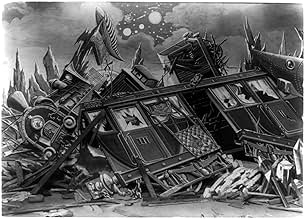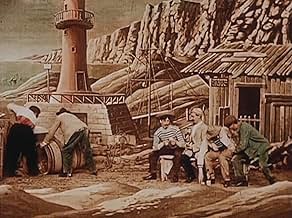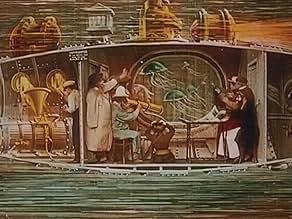AVALIAÇÃO DA IMDb
7,4/10
4,3 mil
SUA AVALIAÇÃO
Adicionar um enredo no seu idiomaUsing every known means of transportation, several savants from the Geographic Society undertake a journey through the Alps to the Sun which finishes under the sea.Using every known means of transportation, several savants from the Geographic Society undertake a journey through the Alps to the Sun which finishes under the sea.Using every known means of transportation, several savants from the Geographic Society undertake a journey through the Alps to the Sun which finishes under the sea.
- Direção
- Roteiristas
- Artistas
Fernande Albany
- Madame Latrouille
- (não creditado)
Jehanne d'Alcy
- Villager at seaport
- (não creditado)
May de Lavergne
- Nurse in Swiss hospital
- (não creditado)
- Direção
- Roteiristas
- Elenco e equipe completos
- Produção, bilheteria e muito mais no IMDbPro
Avaliações em destaque
What an interesting and unusual little feature this is - the combination of Méliès and Jules Verne always produces something worth seeing, and this one is based on one of Verne's most fantastical ideas. It follows a group of scientists and scholars on a very fanciful trip that uses every imaginable form of conveyance, and the story gives Méliès all kinds of opportunities for his trademark visual effects.
Each scene is packed with details, so much so that you cannot even catch it all in one viewing. It is also color-tinted in many places, which adds even more to the effect. The story is just wild, and is less plausible than many Verne stories, but that does not detract from it as entertainment. Méliès even tosses in a little slapstick, which is not too bad for its time. It is similar to, and just a cut below, his film of Verne's "Trip to the Moon", and anyone who enjoyed that classic should also like this one.
Each scene is packed with details, so much so that you cannot even catch it all in one viewing. It is also color-tinted in many places, which adds even more to the effect. The story is just wild, and is less plausible than many Verne stories, but that does not detract from it as entertainment. Méliès even tosses in a little slapstick, which is not too bad for its time. It is similar to, and just a cut below, his film of Verne's "Trip to the Moon", and anyone who enjoyed that classic should also like this one.
Having produced a blockbuster in 1903 in which a group of scientists journeyed to the moon, Melies tried to outdo himself the following year by having another group of manic scientists travel to the sun. He made this film longer and stencilled it in colour, and the outcome is quite astounding. To think that Melies was producing lengthy masterpieces like this while contemporary filmmakers were still experimenting with one-shot narratives goes to show how far ahead of his time Melies really was - which makes his downfall less than a decade later all the sadder. Melies fills the screen with colour with sets sometimes similar to the expressionist sets of the German masterpieces of the late teens and 20s, and fills it also with movement. Not one moment passes when there isn't something to look at. Although this film is not as widely known as Le Voyage dans la lune for my money it surpasses it in terms of exuberance and imagination.
really a great hand colored early science fiction movie with full of early special effects,greatest moment in the film that they reach the sun and go into the suns mouth with a train,this scene is very familiar with the trip to the moon when they reach the moon. The tour through the swiss landscape is also a great moment.
As many others have noted, "The Impossible Voyage" essentially follows the same adventure structure as Méliès's earlier and most popular film, "Le Voyage dans la lune" (1902). They are, after all, both based on works by Jules Verne and Adolphe Dennery. "The Impossible Voyage", however, is more elaborate and nearly or about twice as long--especially with the additional couple minutes that were available as an extended ending to exhibitors at extra cost (this ending hasn't been included on the Image Entertainment and Kino releases, but has been recently rediscovered and may be released on the upcoming Flicker Alley release). According to historian John Frazer, it cost 37,500 francs ($7,500) to make. "The Impossible Voyage" is also more chaotic, or anarchic--lampooning science and the adventures of science fiction to far greater extent. Whereas in "Le Voyage dans la lune", there was a clear journey executed in a rather concise manner, "The Impossible Voyage", instead, follows a group from The Institute of Incoherent Geography, led by an engineer Mabouloff (which translates as "Scatterbrains" and is played by Méliès), and the journey is, indeed, incoherent at times and certainly not concisely executed. On their trip, they crash their automobile (and there seems to be no reason they were even using it) in the mountains and spend some time in a hospital. They also become frozen inside a refrigerator while on the Sun. Furthermore, a journey to the Sun is obviously absurd in itself, unlike that to the Moon, which wasn't too far-fetched to the imagination even in 1902.
The overall result of this is mixed. On the one hand, it's an ambitious and entertaining film for 1904; on the other hand, the increased emphasis on chaos and satire here over that in "Le Voyage dans la lune" dissolves some of the narrative structure and continuity, especially in how it elongates the picture. Additionally, I can only appreciate the theatrical shot-scene, tableau style of Méliès's narratives in limited amounts. The fallacy of attempting to make cinema an extension of theatre, which was one of Méliès's stated goals, was fully exposed as a travesty with the early feature-length films (for example, "Queen Elizabeth" (Les Amours de la reine Élisabeth) (1912)) that were theatrical dramas rather than fantasies with spectacular theatrical effects. It's also not often acknowledged that filmmaker contemporaries of Méliès were already introducing and experimenting with the cinematic techniques of scene dissection, continuity editing and different camera positions. George Albert Smith, whom Méliès had even had correspondence with, was probably at the forefront of early pioneers in this respect, but also by the mid to late 1900s, the Vitagraph and Pathé companies were already employing crosscutting. Later, Méliès was also a contemporary of D.W. Griffith. Thus, I can't give Méliès a total pass because of his era. Yet, for its time and for what it is, "The Impossible Voyage" remains a somewhat entertaining and amusing film to this day, although I rank it lower than "Le Voyage dans la lune" and even some of his other fantasies, such as "Bluebeard" (1901) and "Kingdom of the Fairies" (1903).
On a further note, at this time--in the era of fairground exhibition of cinema--extra-filmic lecturers, or narrators, would aid audiences in following these new complex narrative films, or provide supplemental information to them. Méliès wrote narration to his story films, such as "The Impossible Voyage", for this purpose. Méliès also offered most of his films in hand-colored versions, for which exhibitors would have to pay an extra price (to give some credit, a team of women headed by a Mrs. Thullier hand colored most of them). Fortunately, and unlike some of his other films, "The Impossible Voyage" is generally available today in a hand-colored version with narration. It's helpful, and it works against some of the other limits of the film. Of the narration, however, it's also another example of the primitiveness of Méliès's films; it may be seen as an admission of their lack of cinematic storytelling and self-contained narration (or, as historian Noël Burch would say, it's "non-closed").
The overall result of this is mixed. On the one hand, it's an ambitious and entertaining film for 1904; on the other hand, the increased emphasis on chaos and satire here over that in "Le Voyage dans la lune" dissolves some of the narrative structure and continuity, especially in how it elongates the picture. Additionally, I can only appreciate the theatrical shot-scene, tableau style of Méliès's narratives in limited amounts. The fallacy of attempting to make cinema an extension of theatre, which was one of Méliès's stated goals, was fully exposed as a travesty with the early feature-length films (for example, "Queen Elizabeth" (Les Amours de la reine Élisabeth) (1912)) that were theatrical dramas rather than fantasies with spectacular theatrical effects. It's also not often acknowledged that filmmaker contemporaries of Méliès were already introducing and experimenting with the cinematic techniques of scene dissection, continuity editing and different camera positions. George Albert Smith, whom Méliès had even had correspondence with, was probably at the forefront of early pioneers in this respect, but also by the mid to late 1900s, the Vitagraph and Pathé companies were already employing crosscutting. Later, Méliès was also a contemporary of D.W. Griffith. Thus, I can't give Méliès a total pass because of his era. Yet, for its time and for what it is, "The Impossible Voyage" remains a somewhat entertaining and amusing film to this day, although I rank it lower than "Le Voyage dans la lune" and even some of his other fantasies, such as "Bluebeard" (1901) and "Kingdom of the Fairies" (1903).
On a further note, at this time--in the era of fairground exhibition of cinema--extra-filmic lecturers, or narrators, would aid audiences in following these new complex narrative films, or provide supplemental information to them. Méliès wrote narration to his story films, such as "The Impossible Voyage", for this purpose. Méliès also offered most of his films in hand-colored versions, for which exhibitors would have to pay an extra price (to give some credit, a team of women headed by a Mrs. Thullier hand colored most of them). Fortunately, and unlike some of his other films, "The Impossible Voyage" is generally available today in a hand-colored version with narration. It's helpful, and it works against some of the other limits of the film. Of the narration, however, it's also another example of the primitiveness of Méliès's films; it may be seen as an admission of their lack of cinematic storytelling and self-contained narration (or, as historian Noël Burch would say, it's "non-closed").
Impossible Voyage, The (1904)
*** (out of 4)
Melies attempt to pass his landmark A TRIP TO THE MOON doesn't quite come close to that but this here is still an entertaining little film. Running 20-minutes, this tells the story of a Geographic Society who build a special ship that will take them through the sky, to the sun and then under the sea. That's pretty much the only type of plot we get here as the master Frenchman really makes for an inter sting film that has more going on for it visually than anything story wise. I must admit that I found what little story we have here to be quite boring as none of the human characters are all that interesting (not too uncommon for 1904) but the places they visit really aren't that interesting either. The look of all the locations is what makes this film worth seeing as there's no doubt Melies put a lot of imagination into everything we're seeing. I really loved the hand-colored stuff as this too had imagination behind it and it wasn't just a scribbled mess. The underwater sequence is a good one but the highlight would have to be when the ship goes into the mouth of the sun.
*** (out of 4)
Melies attempt to pass his landmark A TRIP TO THE MOON doesn't quite come close to that but this here is still an entertaining little film. Running 20-minutes, this tells the story of a Geographic Society who build a special ship that will take them through the sky, to the sun and then under the sea. That's pretty much the only type of plot we get here as the master Frenchman really makes for an inter sting film that has more going on for it visually than anything story wise. I must admit that I found what little story we have here to be quite boring as none of the human characters are all that interesting (not too uncommon for 1904) but the places they visit really aren't that interesting either. The look of all the locations is what makes this film worth seeing as there's no doubt Melies put a lot of imagination into everything we're seeing. I really loved the hand-colored stuff as this too had imagination behind it and it wasn't just a scribbled mess. The underwater sequence is a good one but the highlight would have to be when the ship goes into the mouth of the sun.
Você sabia?
- CuriosidadesIncluded in the "Georges Melies: First Wizard of Cinema (1896-1913)" DVD collection, released by Flicker Alley.
- Erros de gravaçãoFor a few seconds, a pole can clearly be seen holding the anthropomorphic sun up.
- Versões alternativasAlso available in a computer colorized version.
Principais escolhas
Faça login para avaliar e ver a lista de recomendações personalizadas
Detalhes
- Data de lançamento
- País de origem
- Idiomas
- Também conhecido como
- An Impossible Voyage
- Locações de filme
- Empresas de produção
- Consulte mais créditos da empresa na IMDbPro
Bilheteria
- Orçamento
- FRF 37.500 (estimativa)
- Tempo de duração
- 24 min
- Cor
- Mixagem de som
- Proporção
- 1.33 : 1
Contribua para esta página
Sugerir uma alteração ou adicionar conteúdo ausente





















